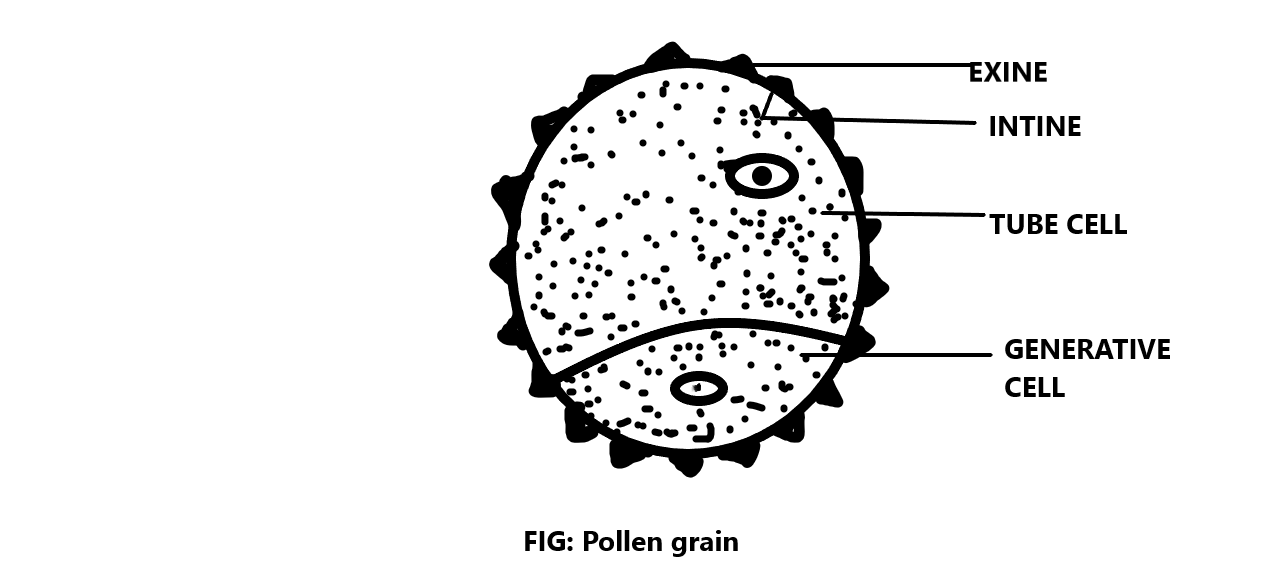
Draw a labelled diagram of the pollen grain.
Answer
563.4k+ views
Hint:-Pollen is a powdery substance which is made of pollen grains. The pollen grains are produced by male microgametophytes of seed-bearing plants and produce male gametes for the sperm cells. The pollens are transferred to the male gametophyte so that the process of pollination can be completed.
Complete step-by-step solution:-
Each pollen grain consists of a vegetative cell and a generative cell. The vegetative cell is a non-reproductive cell and is usually a single cell in most of the flowering plants but may be several in other seed plants. The generative cell is the reproductive cell. The vegetative tube cell produces the pollen tube and generative cells divides to form two sperm cells
The mature pollen grain is covered by a double wall. The outermost wall is tough, resistant and contains cuticles. This wall is known as the exospore or exine. The cuticularized wall is made up of sporopollenin. The inner wall is thin and delicate and surrounds the vegetative and the generative cells. This wall is known as endospore or intine. It is made up of cellulose.
The exine sometimes bears spines or warts and are referred to as echinate. A net like appearance consisting of elements separated from each other by a lumen may also be present and are known as reticulate. The pollen walls serve to protect the sperm while moving from anther to stigma. It protects the pollen grains from drying out. The outer pollen wall prevents the pollen grain from shrinking and crushing the genetic material during dedication.
There are regions on the pollen wall which shows a significant reduction in exine thickness. These regions allow shrinking and swelling of the grain that is caused by changes in moisture content. Pollen grains are also referred to as inaperturate or apertures absent and aceturate where apertures are present.

Note:- The pollen grain is a minute body that developed in the male structures of the seed bearing plants. The main purpose of production of pollen grains is the fertilization or pollination. The pollen grains are carried to the female parts of the plant where fertilization occurs. A pollen grain consists of one or more vegetative cells and a single reproductive cell. The outer layer of pollen grain is called exine and is very tough. The internal layer is known as intine which covers the cells.
Complete step-by-step solution:-
Each pollen grain consists of a vegetative cell and a generative cell. The vegetative cell is a non-reproductive cell and is usually a single cell in most of the flowering plants but may be several in other seed plants. The generative cell is the reproductive cell. The vegetative tube cell produces the pollen tube and generative cells divides to form two sperm cells
The mature pollen grain is covered by a double wall. The outermost wall is tough, resistant and contains cuticles. This wall is known as the exospore or exine. The cuticularized wall is made up of sporopollenin. The inner wall is thin and delicate and surrounds the vegetative and the generative cells. This wall is known as endospore or intine. It is made up of cellulose.
The exine sometimes bears spines or warts and are referred to as echinate. A net like appearance consisting of elements separated from each other by a lumen may also be present and are known as reticulate. The pollen walls serve to protect the sperm while moving from anther to stigma. It protects the pollen grains from drying out. The outer pollen wall prevents the pollen grain from shrinking and crushing the genetic material during dedication.
There are regions on the pollen wall which shows a significant reduction in exine thickness. These regions allow shrinking and swelling of the grain that is caused by changes in moisture content. Pollen grains are also referred to as inaperturate or apertures absent and aceturate where apertures are present.

Note:- The pollen grain is a minute body that developed in the male structures of the seed bearing plants. The main purpose of production of pollen grains is the fertilization or pollination. The pollen grains are carried to the female parts of the plant where fertilization occurs. A pollen grain consists of one or more vegetative cells and a single reproductive cell. The outer layer of pollen grain is called exine and is very tough. The internal layer is known as intine which covers the cells.
Recently Updated Pages
Master Class 12 Social Science: Engaging Questions & Answers for Success

Master Class 12 Physics: Engaging Questions & Answers for Success

Master Class 12 Maths: Engaging Questions & Answers for Success

Master Class 12 Economics: Engaging Questions & Answers for Success

Master Class 12 Chemistry: Engaging Questions & Answers for Success

Master Class 12 Business Studies: Engaging Questions & Answers for Success

Trending doubts
What are the major means of transport Explain each class 12 social science CBSE

Which are the Top 10 Largest Countries of the World?

Draw a labelled sketch of the human eye class 12 physics CBSE

How much time does it take to bleed after eating p class 12 biology CBSE

Explain sex determination in humans with line diag class 12 biology CBSE

Explain sex determination in humans with the help of class 12 biology CBSE




